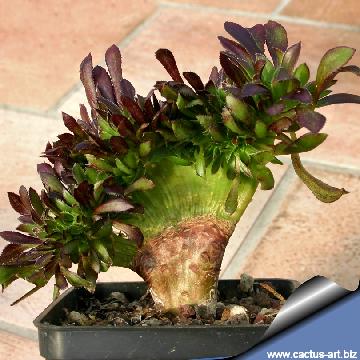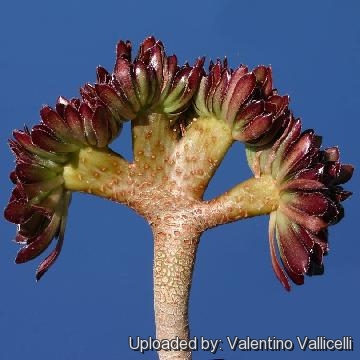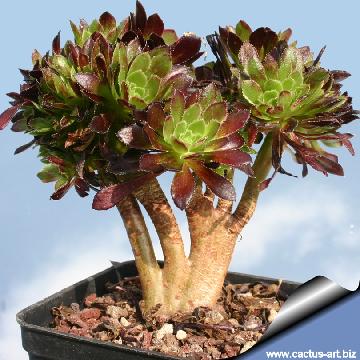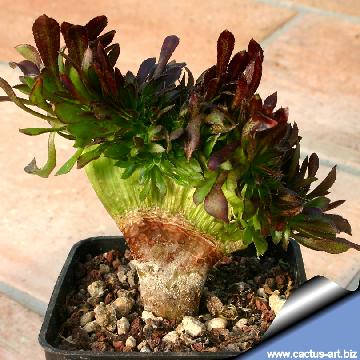
Aeonium arboreum var. atropurpureum forma cristata
This plant has deep purple fan shaped crest that truly stand out against the blue of the sky.
Origin and Habitat: Garden origin (Nursery produced cultivar) For a long time this choicest cultivar has been considered a sport of the Aeonium arboretum. It now seems that it comes from the Canary Islands, thus it then cannot be a cultivar of A. arboreum, since A. arboreum doesn't come from there. The latest theory is that it is a cultivar from A. manriqueorum.
Synonyms:
See all synonyms of Aeonium arboreum
Common Names include:
ENGLISH: Crested Black Beauty, Crested Black rose, Crested Black Tree Aeonium
Description: It is a crested succulent shrub that produces magnificent, fun shaped purple, leaf rosettes at the ends of its branches and seems to to change in and out of its crested mode during the years.
Stem: Forms grey-green beached trunk, spread 25 to 40.
Rosettes: Rosettes are formed at the ends of the stems.
Flowers: Light yellow flowers that form long clusters.
Blooming season: Summer.
Subspecies, varieties, forms and cultivars of plants belonging to the Aeonium arboreum group
Bibliography: Major references and further lectures
1) Forest & Kim Starr “Aeonium sp. (Aeonium)”. Plants of Hawaii. <http://www.starrenvironmental.com>. Web. 27 Sep. 2014.
2) Sunniva Harte “The Perfect Garden: The Best Plants for the Best Design” Trafalgar Square Pub., 2001
3) Tom Hart Dyke “An Englishman's Home: The Adventures Of An Eccentric Gardener” Random House, 15/Dec/2010
4) Guy De Chauliac “Commentary” BRILL, 1997
5) Umberto Quattrocchi “CRC World Dictionary of Plant Names: Common Names, Scientific Names, Eponyms, Synonyms, and Etymology” CRC Press, 29/Nov/1999
6) Reid V. Moran “Aeonium arboreum var. arboreum (Linnaeus) Webb & Berthelot [family CRASSULACEAE] Flora of North America” Vol 8 Magnoliophyta: Paeoniaceae to Ericaceae. Flora of North America Editorial Committee. 2009.
7) J. G. Baker. “Flora of Tropical Africa” Vol 2, page 385 1871
8) “RHS A-Z encyclopedia of garden plants.” United Kingdom: Dorling Kindersley. 2008
9) Urs Eggli “Illustrated Handbook of Succulent Plants: Crassulaceae” Springer Berlin Heidelberg, 05/Nov/2012
10) Bruce G. Baldwin, Douglas H. Goldman “The Jepson Manual: Vascular Plants of California” University of California Press, Berkeley 01/Jan/2012
 Aeonium arboreum atropurpureum f. cristatum Photo by: Cactus Art
Aeonium arboreum atropurpureum f. cristatum Photo by: Cactus Art Aeonium arboreum atropurpureum f. cristatum Photo by: Valentino Vallicelli
Aeonium arboreum atropurpureum f. cristatum Photo by: Valentino Vallicelli Aeonium arboreum atropurpureum f. cristatum Photo by: Cactus Art
Aeonium arboreum atropurpureum f. cristatum Photo by: Cactus Art Aeonium arboreum atropurpureum f. cristatum Photo by: Cactus Art
Aeonium arboreum atropurpureum f. cristatum Photo by: Cactus ArtCultivation and Propagation: It requires gritty well drained potting mix. Water deeply but infrequently. Plants are allowed to thoroughly dry in-between waterings. During the winter months restrict water to about once a month, or just enough to keep the foliage from shrivelling. Position in full to part sun in a sheltered spot, but the bright light enhances the rich hues of the darker Aeoniums, and the subtle blushes of the other colours, but prefers light shade to shade in summer. The plants tend to go dormant in the summer and look a little tired sometimes, but they perk up again in the fall. Summer is the natural dormant season for this species in its native land. Needs protection from severe winter frosts (Hardy to -2°C or a little less for short periods), over winter under glass in all but the mildest of gardens.
Crested growth: Unlike 'monstrose' varieties of plants, where the variation from normal growth is due to genetic mutation, crested growth can occur on normal plants. Sometimes it's due to variances in light intensity, or damage, but generally the causes are unknown. A crested plant may have some areas growing normally, and a cresting plant that looks like a brain, may revert to normal growth for no apparent reason. If you have any of the crested part left you need to remove the normal growth and leave the crested part behind this will need to be done regularly.
Propagation: It is easily propagated by cuttings in the spring. When the stem becomes too tall, just cut the top rosette with a piece of stem and plant it. It will soon take root, while the plant left with just the stem will soon grow new buds that can be in turn used for propagation. Time to take cuttings: April to July














